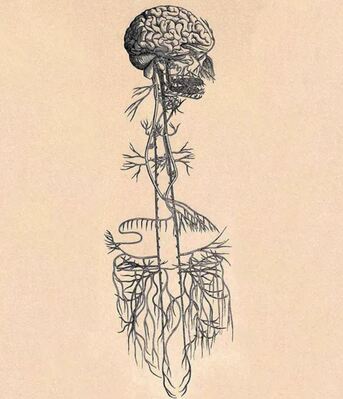|
The vagus nerve is the longest nerve in the body that originates in the brain, travels down the neck and connects to the digestive system, liver, spleen, pancreas, heart and lungs and regulates digestion, heart and respiratory rate. It has a key role in reducing inflammation, lowering blood pressure and balancing our hormones and helps us recover from stress. A good description is that it's the superhighway of your body, transporting vital information between your brain and the rest of your internal organs.
Unfortunately these days many of us spend far too much time in “Fight flight” mode which, whilst designed to help us escape life-threating situations, is not a healthy state to be in for more than a few minutes. With your heart rate and blood pressure increasing to move blood, nutrients and oxygen to your major muscle groups, pupils dilating to see better and heightened senses and stress hormones circulating throughout your body, you're shaky and tense halting your normal body functions. Even our memory IQ and creativity are reduced! Meanwhile, the “Rest and Digest” mode is the biological opposite when healing and regeneration occur and the body performs activities like digesting, detoxifying, eliminating, and building immunity. That's where we want to be especially when we are stretching. Improving your vagal tone improves the function of many body systems, causing better blood sugar regulation, reduced risk of stroke and cardiovascular disease, lower blood pressure, improved digestion and reduced migraines. Higher vagal tone is also associated with better mood, less anxiety and more stress resilience. Stephen Porges Polyvagal theory goes beyond the traditional theory of these two states and puts social relationships front and centre with a more sophisticated understanding of the biology of safety and danger, based on the subtle interplay between the visceral experiences of our own bodies and the voices and faces of the people around us. It explains why a kind face or a soothing tone of voice can dramatically alter the way we feel and why knowing that we are seen and heard by the important people in our lives can make us feel calm and safe. He provides new approaches to healing that focus on regulating the vagus nerve which include stretches and eye movement to remove restriction of blood supply and improve functioning of the vagus nerve. We can easily integrate these into your stretch routine. You can also improve vagal tone with cold water therapy, even splashing your face with cold water in the morning and before bed, as it activates a primal reflex called the mammalian dive reflex, designed to slow our bodies down when diving into water. Using your voice, chanting, singing, laughing and even gargling activate the vagus nerve and slow you down. And of course our breathing patterns reflect vagal tone. Slower and deeper breathing quietens a fired up system. This beautiful breathing pacer is a lovely way to practice breathing slowly to settle your nervous system https://youtu.be/AWsWaa29HHk.
1 Comment
|
MargieI'm Margie, the owner of A Good Stretch. I love helping you feel good! Archives
April 2024
Categories |
Photo from shixart1985


 RSS Feed
RSS Feed
